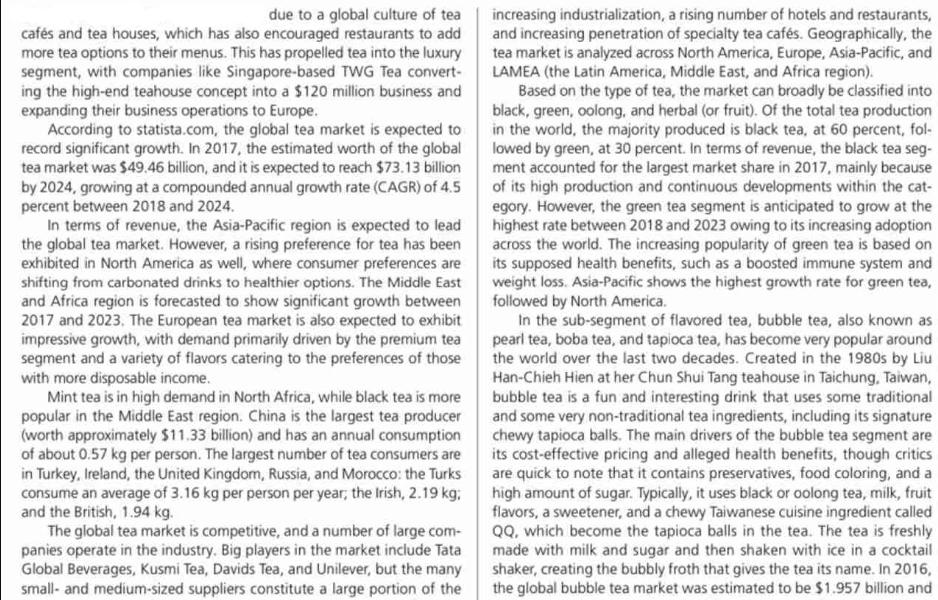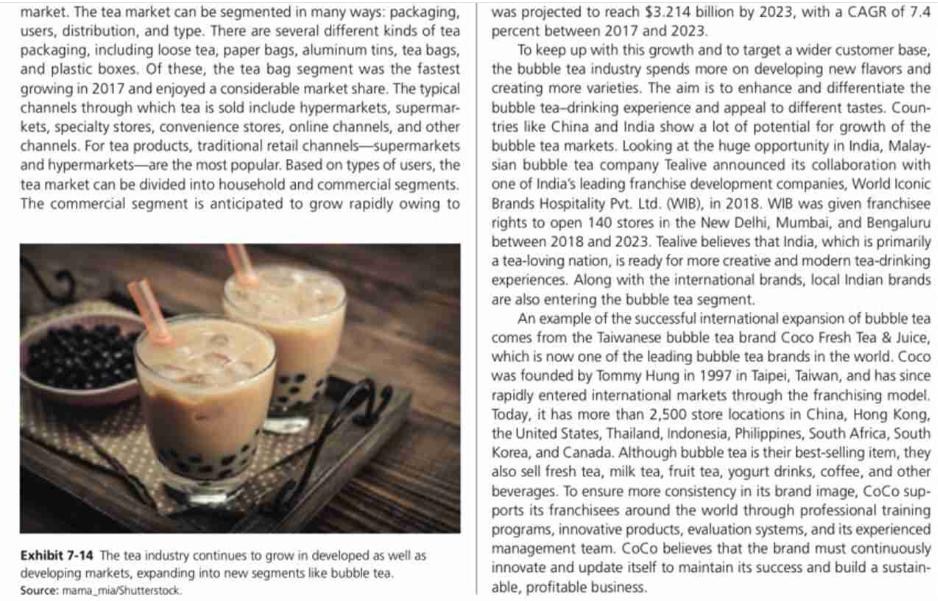Question
Consider the different tea markets around the world. What are the main growth drivers of the global tea industry? Discuss the segmentation of the global


Consider the different tea markets around the world. What are the main growth drivers of the global tea industry?
Discuss the segmentation of the global tea industry. With more tea products and varieties being introduced, do you think the sales growth of the industry will be sustainable?
The coffee industry has big brands like Starbucks, Tim Hortons, Nescafé, and Second Cup. How important is branding and positioning for the tea industry?
Do you think the bubble tea segment will continue to grow? What can international brands like Coco and Tealive do to strengthen their global positions?
due to a global culture of tea cafs and tea houses, which has also encouraged restaurants to add more tea options to their menus. This has propelled tea into the luxury segment, with companies like Singapore-based TWG Tea convert- ing the high-end teahouse concept into a $120 million business and expanding their business operations to Europe. According to statista.com, the global tea market is expected to record significant growth. In 2017, the estimated worth of the global tea market was $49.46 billion, and it is expected to reach $73.13 billion by 2024, growing at a compounded annual growth rate (CAGR) of 4.5 percent between 2018 and 2024. In terms of revenue, the Asia-Pacific region is expected to lead the global tea market. However, a rising preference for tea has been exhibited in North America as well, where consumer preferences are shifting from carbonated drinks to healthier options. The Middle East and Africa region is forecasted to show significant growth between 2017 and 2023. The European tea market is also expected to exhibit impressive growth, with demand primarily driven by the premium tea segment and a variety of flavors catering to the preferences of those with more disposable income. Mint tea is in high demand in North Africa, while black tea is more popular in the Middle East region. China is the largest tea producer (worth approximately $11.33 billion) and has an annual consumption of about 0.57 kg per person. The largest number of tea consumers are in Turkey, Ireland, the United Kingdom, Russia, and Morocco: the Turks consume an average of 3.16 kg per person per year, the Irish, 2.19 kg; and the British, 1.94 kg. The global tea market is competitive, and a number of large com- panies operate in the industry, Big players in the market include Tata Global Beverages, Kusmi Tea, Davids Tea, and Unilever, but the many small and medium-sized suppliers constitute a large portion of the increasing industrialization, a rising number of hotels and restaurants, and increasing penetration of specialty tea cafs. Geographically, the tea market is analyzed across North America, Europe, Asia-Pacific, and LAMEA (the Latin America, Middle East, and Africa region). Based on the type of tea, the market can broadly be classified into black, green, oolong, and herbal (or fruit). Of the total tea production in the world, the majority produced is black tea, at 60 percent, fol- lowed by green, at 30 percent. In terms of revenue, the black tea seg- ment accounted for the largest market share in 2017, mainly because of its high production and continuous developments within the cat- egory. However, the green tea segment is anticipated to grow at the highest rate between 2018 and 2023 owing to its increasing adoption across the world. The increasing popularity of green tea is based on its supposed health benefits, such as a boosted immune system and weight loss. Asia-Pacific shows the highest growth rate for green tea, followed by North America. In the sub-segment of flavored tea, bubble tea, also known as pearl tea, boba tea, and tapioca tea, has become very popular around the world over the last two decades. Created in the 1980s by Liu Han-Chieh Hien at her Chun Shui Tang teahouse in Taichung, Taiwan, bubble tea is a fun and interesting drink that uses some traditional and some very non-traditional tea ingredients, including its signature chewy tapioca balls. The main drivers of the bubble tea segment are its cost-effective pricing and alleged health benefits, though critics are quick to note that it contains preservatives, food coloring, and a high amount of sugar. Typically, it uses black or oolong tea, milk, fruit flavors, a sweetener, and a chewy Taiwanese cuisine ingredient called QQ, which become the tapioca balls in the tea. The tea is freshly made with milk and sugar and then shaken with ice in a cocktail shaker, creating the bubbly froth that gives the tea its name. In 2016, the global bubble tea market was estimated to be $1.957 billion and
Step by Step Solution
There are 3 Steps involved in it
Step: 1
Main Growth Drivers of the Global Tea Industry The global tea industry is experiencing significant growth driven by several key factors Rising Health Consciousness The shift in consumer preferences fr...
Get Instant Access to Expert-Tailored Solutions
See step-by-step solutions with expert insights and AI powered tools for academic success
Step: 2

Step: 3

Ace Your Homework with AI
Get the answers you need in no time with our AI-driven, step-by-step assistance
Get Started


